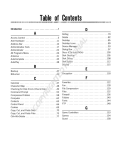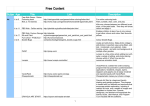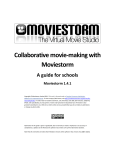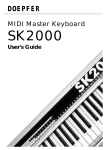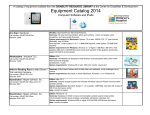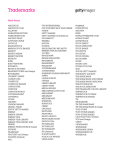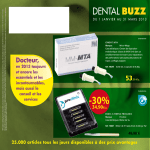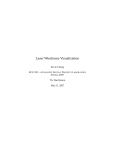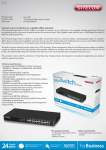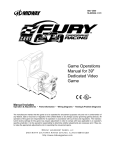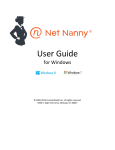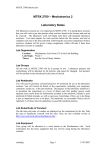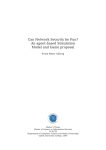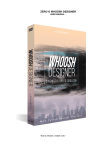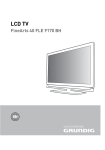Download Carnival of Science education kit
Transcript
Prepared by Janet Marlow, Scienceworks contractor and Patricia Christies Program Coordinator, Scienceworks Bookings 03 9392 4819 weekdays 8.30am – 4.30pm. Copyright Museum Victoria 2013 Teachers may photocopy this kit for educational purposes. http://museumvictoria.com.au/scienceworks/education/ Contents Teacher Notes Introduction 3 Carnival of Science exhibition description 4 Exhibition map 15 Student Activities Pre/post-visit activities for Years 5 - 8 students 16 Activities during visit for Years 5 - 10 students 24 Post-visit activities 9 - 10 28 Rich Learning Tasks for Years 5 - 10 students 30 Resources Websites 37 2 http://museumvictoria.com.au/scienceworks/education/education-programs/carnival-ofscience-exhibition/ Teacher Notes Introduction Carnival of Science presents the fun of the fair and amusement park games together with the physics, biology or psychology behind them. Students can explore a range of traditional sideshow attractions testing mind and body, whilst discovering how science can help win a game or understand an illusion. This exhibition is accessible at multiple levels, providing a variety of physical challenges and memorable thrills. Details of each exhibit and background explanations are provided on pages 4 - 14. Some activities highlighting observational skills and ball spinning techniques are suggested prior to visiting this exhibition to alert students to some of the tricks behind carnival games. Carnival customers normally ‘pay to play’ and try to win prizes; the owners need to make money and give away few prizes, so sideshow games are fun but more difficult than they first appear. Experiences in Carnival of Science can form the basis for an investigation of motion, force and momentum or the tricks and illusions behind sideshow games. Why do we enjoy being scared? How can science help to design an exhilarating rollercoaster ride? Will top or bottom spin help to win a prize? ‘Man with Clowns’, Luna Park St Kilda, c1960s by Maggie Diaz Image courtesy of Maggie Diaz Collection, State Library of Victoria 2013 Copyright Maggie Diaz www.maggiediaz.com This education kit has been written for Years 5 - 10 to support the Carnival of Science exhibition at Scienceworks. The exhibition is available for school bookings from 1 February. The kit contains information to assist with: • setting a context for the excursion so that students can get the most from their visit • further exploration into the world of carnival games and amusement parks. The writers assume that teachers have read the contents of the kit and prepared the students for their visit to the exhibition. The activities in this education kit are designed to engage and assist students in exploring science in the context of carnival games and rides. 3 http://museumvictoria.com.au/scienceworks/education/education-programs/carnival-of-science-exhibition/ Teacher Notes Exhibition description Entrance The entrance to Carnival of Science is an experience in itself. Anyone going inside seems to disappear in an instant. However, visitors are safely exiting the other side after stepping through a hidden, dark revolving door. Face your fear Place your head and hands in the holes and release the guillotine. Will your nervous system respond to the fear you feel as if it were a real guillotine? Crazy clowns Place five table tennis balls into the mouth of one crazy clown. See how many you can get to roll down into the number one or number six slot. The speed of the head changes as it approaches each edge, making this very difficult. This is why the best prizes are awarded for the most difficult scores to achieve (5 and 30) in a real sideshow. 4 http://museumvictoria.com.au/scienceworks/education/education-programs/carnival-of-science-exhibition/ Teacher Notes Wacky wire Move the ring around the wire without touching it. Increase the challenge by pulling the lever to make the wire move clockwise then anticlockwise. Which one is harder? Your eyes and brain are constantly working together, moving your muscles to adjust the position of the ring. This is easiest when the spiral moves clockwise through the ring because you only have to move the ring downwards (harder than when spiral is not moving since you need to move ring down and around at same time). Cover up This is a traditional carnival game where visitors are asked to cover a large disc with five smaller discs. The smaller discs are a particular size relative to the larger disc so the five need to be strategically placed to be successful. The small discs must just cover the centre of the large one and minimally overlap each other. Curve ball Two participants collect some balls and sit on their respective chairs secured by a harness. They throw a ball to each other when the machine is stationary, then try when the machine is moving. Participants will need to predict where their partner will be when receiving the ball and throw to that location if the other participant is to be able to catch it. 5 http://museumvictoria.com.au/scienceworks/education/education-programs/carnival-of-science-exhibition/ Teacher Notes Rebound Rebound requires the visitor to throw a plastic ball at the target on the angled backboard, attempting to get the ball to land in and stay in the basket. A ball thrown straight at a flat surface will bounce off at a similar angle and speed, missing the basket. Throwing with topspin on the ball is more likely to be successful, as it rebounds slower and at a different angle so less likely to bounce out. (Topspin spins the ball away from you as it travels.) In it to win it In it to win it requires the visitor to throw a ball so it lands in the bucket without bouncing out. When throwing with backspin on the ball (and hitting the side of the bucket) you are more likely to be successful, as the ball will bounce lower and slower. Backspin occurs when a ball rotates backwards towards you after being thrown. Stacks of fun Stack three cans in a pyramid then try to knock over all the cans with one ball. In order for the light ball to have enough momentum to push over all three cans, it will need to travel at a very high speed. (A heavier ball would need less speed to apply the same force.) These cans are also weighted at the bottom which means it takes more force to tip them over. 6 http://museumvictoria.com.au/scienceworks/education/education-programs/carnival-of-science-exhibition/ Teacher Notes Revolution This exhibit is designed to disorientate visitors. Step underneath the spinning curtain and look at the vertical black and white stripes on the inside. Looking at moving stripes may make you feel dizzy, but this fades if you look at the still floor. Conflicting messages to the brain from your body muscles (standing still) and your eyes (seeing movement) cause the dizziness. Head spin Tilt the model head and turn the handle to make both the head and fluid in the inner ear spin. When the head stops spinning, the fluid keeps moving. When this happens to you, it would send conflicting messages to your brain. Your inner ears say your head is moving and your eyes say it has stopped, again causing dizziness until the fluid stops moving. Framed Peep through the viewer and turn the handle. The speed of the handle will determine whether you see the individual pictures, a flickering film or smooth moving images. The illusion of smooth movement is created if the frames change quickly enough. When your eyes see more than fifteen images per second, the visual cortex in your brain perceives one image while the next is being processed, creating an illusion of smooth movement. 7 http://museumvictoria.com.au/scienceworks/education/education-programs/carnival-of-science-exhibition/ Teacher Notes Zoltan, Fortune Teller (foyer) Place your hand on Zoltan’s palm reader and a fortune is revealed. There are 16 possible recordings randomly selected, each one so vague that you may think that something in the fortune you received has come true. People sometimes want to believe that two unrelated events, or a coincidence, are related. This is known as the personal validation effect. Spun out Spin the doughnut shaped container as fast as you can. If fast enough, the ducks inside will rotate with the water and lean over. This is because buoyancy (the upward force of liquid on an object) always remains perpendicular to the water surface. When the water is still, buoyancy balances gravity. When the container spins, the water surface curves and buoyancy pushes on ducks towards the centre while gravity still pulls them down, and the ducks lean sideways. Pluck a duck This exhibit requires good hand and eye coordination, using a wand to scoop up a duck. Catch a duck and read the fun fact beneath it. 8 http://museumvictoria.com.au/scienceworks/education/education-programs/carnival-of-science-exhibition/ Teacher Notes Strength tester Jump on the yellow metal plate as hard as you can. The scale will measure the force you apply. The plate will push a lever which hits a ball, transferring kinetic energy from you to the ball. If you transfer enough kinetic energy (movement energy), the ball can rise up to the top of the scale and make the bell ring. Roller coaster Place a ball on the highest end of the track and let it go. Does it have enough energy to go up and down all the hills and reach the end of the track? When the ball is released it has some potential (stored) energy due to its height above the floor. As it goes down a hill it speeds up as potential energy changes to kinetic energy. Going uphill it slows as kinetic energy changes back to potential energy. The ball also loses energy as it rolls due to friction, so has less energy and only climbs lower hills. Lift yourself Sit on one of seats and pull on the rope to lift yourself up. Then sit on the other seat and try again. Each rope passes through a set of pulleys that change the direction and size of the force (your pull) needed to raise a load (your weight). More pulleys make it easier to pull yourself up, but you pull a longer length of rope to lift yourself. The pulleys and bar form a block and tackle. http://museumvictoria.com.au/scienceworks/education/education-programs/carnival-of-science-exhibition/ 9 Teacher Notes Air cannon Aim the cannon at the target then pull the knob towards you and let it go. The air inside the barrel is compressed when the plunger is released, sending a shock wave through the air at the other end. The wave retains its speed and shape long enough to hit the target several metres away if no other forces intervene. The momentum of the air wave applies the force to move the tinsel in the target. Merge your face Sit in the chair in front of the mirror with someone else on the opposite side. When you look at the mirror, you see strips of your own reflection alternating with strips of your partner seen through the spaces between the mirrors. Your brain merges the strips to form the image of an unfamiliar face. You may feel uneasy as your brain recognizes it’s not your familiar reflection. Mirror maze Enter the mirror maze and try to make your way out. Multiple reflections from the mirrored walls can make this a difficult task. Looking down at the dark floor and identifying real corners will help you find the exit. 10 http://museumvictoria.com.au/scienceworks/education/education-programs/carnival-of-science-exhibition/ Teacher Notes Head on a platter Crouch down and enter though the room at the back of this exhibit and then stand up, placing your head on the platter. The mirrors create the illusion of a severed head on the platter. A great photo opportunity! Transform yourself With someone watching from the front, enter the exhibit from the side and press the button. Then swap places. Visitors outside will see you transform into a gorilla as the light in your compartment dims and the gorilla’s compartment lights up. This exhibit uses a half silvered angled mirror providing transmitted and reflected light to create this illusion. Square wheels Hold onto the rails, step on the cranks and start pedaling. The size and shape of the curved bumps correspond to the dimensions of the square wheels, making it a smoother ride than you might expect (as long as you don’t try to turn). These curves are a catenary, the shape made by a hanging cable when supported at both ends. 11 http://museumvictoria.com.au/scienceworks/education/education-programs/carnival-of-science-exhibition/ Teacher Notes Treading lightly How softly can you walk? Sensors under the walkway detect pressure placed on the floor. In order to reach the end without detection, you must minimise the pressure your foot places on the floor surface. Hydraulics Sit on one seat and ask someone else to sit on the other seat. The seats are connected in pairs by tubes filled with fluid. When you sit on one, fluid in the tubes is pushed towards the other seat. How much the seats move up and down is dependent on your weight and the weight of the other person. Crazy bikes The handlebars on an ordinary bike are connected directly to the front wheel. Turning the handle bars left or right turns the front wheel in the same direction. On this crazy bike, the steering is reversed, making it difficult to ride. You will need to learn how to ride this type of bike all over again. 12 http://museumvictoria.com.au/scienceworks/education/education-programs/carnival-of-science-exhibition/ Teacher Notes Cone up a hill Try each roller to see which one rolls up the hill on the V-shaped track. This illusion is created by the shape of the object and the shape of the cone. Railway tracks Place each set of wheels at the high end of the track. Roll them down the hill. Can you roll them to the end of the track? If coned wheels meet a bend in the track, the circumference of the wheel in contact with the outside rail increases, causing it to travel further than the inside wheel. This steers the wheel into the bend. Bed of nails Dare to lay down on this bed of nails. Your weight is distributed across thousands of nails, making it a surprisingly painless experience. 13 http://museumvictoria.com.au/scienceworks/education/education-programs/carnival-of-science-exhibition/ Teacher Notes Spinning top Hold on the handle and rotate the platform. The speed of your rotation will depend on the size of the circle you make with your body. The larger the circle, the slower you will go. The smaller the circle, the faster you will go. You might have seen a figure skater spin faster by pulling their arms closer to their body. All Images Copyright Museum Victoria 14 http://museumvictoria.com.au/scienceworks/education/education-programs/carnival-of-science-exhibition/ Teacher Notes Exhibition map 15 http://museumvictoria.com.au/scienceworks/education/education-programs/carnival-of-science-exhibition/ Student Activities Pre/post visit activities for Years 5 – 8 (Teacher led) Activity 1: Carnival skills Have you been to a fairground or Luna Park? Did you play the carnival games where you had to hit a target to win? Did you get a prize, first go? Carnival games are fun and test your skills, but are often more difficult to win than you think. Before you visit Scienceworks, here are some things to do that may improve your chances in the Carnival of Science games. • Watch the video Midway Games by Mary Jane and Eliza from PBS Dragonfly TV. http://pbskids.org/dragonflytv/show/midwaygames.html How can you make a carnival game more difficult to win? What you need One tennis ball An outdoor wall A friend What to do 1. Bounce the tennis ball onto the ground, and up a wall. Where does it hit the wall? 2. Repeat step one but this time give the ball a spin as it leaves your hand. Does it bounce up the wall differently? 3. Spin the ball again and try bounding the ball to a friend. Does spinning the ball make it difficult to predict the direction of the ball? 4. Experiment with other types of balls and types of spin. (Refer to the diagrams below for assistance.) Image source: The science behind the fun sideshows activity booklet developed by Questacon, The National Science and Technology Centre. 16 http://museumvictoria.com.au/scienceworks/education/education-programs/carnival-of-science-exhibition/ Student Activities Image source: The science behind the fun sideshows activity booklet developed by Questacon, The National Science and Technology Centre. More science Normally, a ball bounces off at an angle which is similar to the angle at which it hits the surface. Sports people often spin the ball to make it move in unexpected ways (to outsmart the opposition). When a ball spins, it may grip more or skid as it hits the surface (such as the ground or tennis racquet). This changes the way the ball bounces and makes it harder to predict where it is going. 17 http://museumvictoria.com.au/scienceworks/education/education-programs/carnival-of-science-exhibition/ Student Activities Activity 2: Carnival skills Some games are easier when you can predict what will happen. What you need A clear glass with a wide mouth One marble A smooth table top What to do 1. Place the marble on the table. 2. Turn the table upside down so it covers the marble. 3. Move the glass around so the marble starts spinning around the rim inside the glass. 4. Predict what will happen when you lift the glass up. 5. Lift the glass. What happens to the marble? Image source: The science behind the fun sideshows activity booklet developed by Questacon, The National Science and Technology Centre. More science Once something starts moving, it will keep moving in a straight line. It will only stop or change direction if it gets pushed or hits something. The marble is moving in a circle because the glass is pushing it around. As soon as you lift the glass, the marble will fly or roll out in a straight line. This push towards the centre that makes the marble go around in a straight line is called centripetal force. 18 http://museumvictoria.com.au/scienceworks/education/education-programs/carnival-of-science-exhibition/ Student Activities Activity 3: Carnival thrills The most popular attractions at fun parks are often the ones that are scary or thrilling. Have you ridden a rollercoaster or experienced a sudden fright? Do you remember what it felt like? The Scenic Railway at Luna Park Melbourne is the world’s oldest continually-operating roller coaster. Image source: WikiMedia Commons Think of carnival ride which you think has a ‘thrill factor’. How do you think your body might react during the ride? □ □ □ Dizziness Dry mouth Upset stomach □ □ □ Rapid breathing Faster heart rate Tense muscles □ □ □ Trembling Cold hands Unable to move Why might your body react this way? 19 http://museumvictoria.com.au/scienceworks/education/education-programs/carnival-of-science-exhibition/ Student Activities Activity 4: Carnival thrills Sometimes carnival attractions use illusions to provide an unexpected experience. Find out how to change your reflection using shiny spoons. What you need Different sized shiny spoons (new or polished with a cloth) What to do 1. Choose one spoon to start with and look at your reflection in both sides. Do you look different? 2. Move the spoon back and forth as you look. 3. How does this change your reflection? 4. Can you find a position where there is no clear reflection? 5. Try other shiny spoons. Does the size of the spoon change the type of reflection you see? More science The underside of the spoon gives a small image. It acts like a convex mirror (curved mirror that bulges outward). What you see in the bowl of the mirror depends on how close or far away you are to the spoon. This side of the spoon is like a concave mirror (curved mirror that bulges inward). Up close, your image is larger. When you place the spoon further away, your image is upside down! At one particular distance (point) from the spoon, it is impossible to make sense of what you see. Image source: The science behind the fun sideshows activity booklet developed by Questacon, The National Science and Technology Centre. Activity 5: My very own sideshow How many carnival games have you played? Do you have an idea for a fun new game? You might base it on one in the Carnival of Science sideshows (pages 4 - 14) or find out about some others. (e.g. www.wikipedia.org/wiki/Carnival-games ). Describe your idea, and consider: What will make it fun? How will it work? Who will enjoy it? How could you build it? Draw a diagram of your game and label all the main parts. What exciting name would attract customers to play your carnival game? Create a presentation that shows how your carnival game would work, using a slideshow or other media, and/or a working model. 20 http://museumvictoria.com.au/scienceworks/education/education-programs/carnival-of-science-exhibition/ Student Activities Activity 6: Roller coaster ride Have you been on a roller coaster? What makes the ride fun? How does it work? What you need Small shiny balls (eg. Ball bearings or those used for cake decoration) Clear plastic tubing or garden hose without spray fittings (at least 2.5m long) Friends to hold the tubing in place What to do 1. Use clear plastic tubing or garden hose as the roller coaster track, with some small ball-bearings or cachous (small silver balls for cake decoration) as the cars. 2. Hold one end of the tubing/hose up higher than the other and put a ball in the high end. Did the ball roll to the other end? 3. Try other heights. What do you notice? 4. Bend a loose loop into the middle of the tubing/hose. How high does the ball have to start from to get through the loop? Try round and oval shaped loops. 5. Can your ball travel around corners? Through corners and more than one loop? Make your ball go as fast as possible. More science A roller coaster car needs to start from very high up so it can go over the hills and around the curves to the end of the track. It starts with a lot of potential energy, which changes to kinetic energy as it goes downhill then changes back to potential energy as it slows going up the next hill. As the car rolls it also loses some energy due to friction; eventually it loses all of its energy and stops moving. The "Screamin'" rollercoaster track that enters the water at Disney's California Adventure Park. Anaheim, CA, USA Image source: WikiMedia Commons 21 http://museumvictoria.com.au/scienceworks/education/education-programs/carnival-of-science-exhibition/ Student Activities Activity 7: Carnivals are…fun? Gathering ideas Use the Exhibition description (pages 4 – 14) and your pre-visit activities to gather all the information relevant to your task. What are some of the carnival games you would like to try in the exhibition? What other exhibits would you want to try? Why? What experiences do you enjoy the most? (e.g. throwing balls, seeing illusions, feeling dizzy, winning games…) Choose one of these carnival experiences to work with. Create a Mind Map in the space below around your chosen experience, based on possible ideas it could lead to. Write your central experience (theme) in the box provided below. (Alternatively, create an electronic Mind Map with Bubbl, Mindmeister, Apple Apps or other software, see Resources page 37) Experience or THEME Choose one of these ideas to work with on another Mind Map (over page). 22 http://museumvictoria.com.au/scienceworks/education/education-programs/carnival-of-science-exhibition/ Student Activities Create a Mind map for your ideal carnival game or attraction. What will it look like? How does it work? What materials would it made from? Who will enjoy using it? And so on. Write your central idea (the Carnival game or Carnival Attraction) in the box provided below. Carnival Game or Attraction Sketch an illustration of what your Carnival Game or Attraction might look like below. 23 http://museumvictoria.com.au/scienceworks/education/education-programs/carnival-of-science-exhibition/ Student Activities Activities during visit for Years 5 - 10 Activity 8: Experience carnival! Organise yourselves into groups of two or three. Try some carnival games listed below. Make sure you have a go at three or more under each heading highlighted in bold. Moving Curveball, Crazy Clowns, Rebound, In it to win It, Crazy Bike, Spinning Top, Spun Out, Wacky Wire. Forceful Stacks of Fun, Rollercoaster and Railway Tracks, Air Canon, Strength Tester, Lift Yourself, Hydraulics, Tread Lightly, Bed of Nails For each game you try, discuss with your group: • How it works? • What you would change about it to make it better? Record the answers in the table below. Experience some of these pairs of sideshow attractions: Amazing Entrance door and Face Your Fear, Mirror Maze and Revolution, Transform Yourself and Merge Your Face or Head on a Platter. At each exhibit discuss the following questions: What did you see/hear? What did you feel like? Why do you think you felt that? Record the answers in the table below. MOVING FORCEFUL AMAZING 24 http://museumvictoria.com.au/scienceworks/education/education-programs/carnival-of-science-exhibition/ Student Activities Activity 9: Carnival design worksheet For the five games or attractions you have chosen in Carnival of Science, describe the good and bad features of each then add your suggestions for modifications (changes) in the columns below. Titles of selected exhibits: 1. __________________________________ 2. _______________________________ 3. ___________________________________ 4. ______________________________ 5. ___________________________________ You may also wish to take photos or video sequences of each exhibit showing these features. Good features Bad features Suggested modifications 1 2 3 4 5 25 http://museumvictoria.com.au/scienceworks/education/education-programs/carnival-of-science-exhibition/ Student Activities Activity 10: Gathering ideas worksheet Use this worksheet to sketch or write some ideas during your visit to the Carnival of Science exhibition. What are the features of two particular carnival game(s) or attraction(s) that made them such fun? You can use the words in the table as prompts, add some others, or simply write your own table. If you have a camera, use these words to help you select photos or video sequences. For your report back at school, be careful to only include the faces of people you know, and ask their permission before you photograph them. Title of game/attraction: ____________________________________________________ Overall concept Size What’s it made from? Special features The science behind it… How it works? You will have fun with this game/attraction because... You will have more fun trying this with a group of friends because... Other... 26 http://museumvictoria.com.au/scienceworks/education/education-programs/carnival-of-science-exhibition/ Student Activities Activity 11: Believe it? Worksheet Here are some examples of carnival attractions based on illusions. Try out these exhibits and write your answers in each column or record them on mp3 recorder, mobile phone, or other device. Exhibit What did you see/hear? What did you feel like? Why do you think you felt like that? See blade falling down and hear sound effect of guillotine. Rush of air on back of neck. Nervous/scared before and then relieved/happy nothing went wrong and wasn’t hurt. Prior knowledge of what a guillotine does, and what eyes/ears tell makes your brain anticipate a fright and adrenaline is released. Mirror maze Revolution Transform yourself Merge your face Head on a platter Entrance door Face your fear Example: 27 http://museumvictoria.com.au/scienceworks/education/education-programs/carnival-of-science-exhibition/ Student Activities Post-visit activities for Years 9 - 10 Activity 12: Design a carnival sideshow Your mission: Choose one of the games presented in the Carnival of Science exhibition. Improve its design or function and make it more exciting. Describe how the game works. Use the information that you collected about this game/attraction during your visit to the exhibition (Activity 9: Carnival design worksheet or Activity 10: Gathering ideas worksheet) as well as other research. What changes or modifications will make it more exciting? Draw a detailed illustration or build a model of your new design, highlighting any changes or modifications. You may need to make a prototype (working model) to test that it works. Present your design. Explain how your modifications work and how it enhances the original game. Activity 13: Can you believe it? Your mission: Create a sideshow attraction for Luna Park using an illusion that is funny or momentarily frightening and can be experienced by two or more people. Use the information from your Activity 11 Believe it? Worksheet. Things to consider: What materials would you use to make it? How can you test if the illusion works? Are there any times when your illusion might not work? Catchy names for your new sideshow attraction. Is there a particular audience for this attraction? Would you recommend it to a friend? You will need to record all your tests and descriptions of any tests in a digital format (eg. slideshow or documentary-style video). Resources: Free sound effects and music loops for educational projects: www.royaltyfreemusic.com/soundeffects.html and www.royaltyfreemusic.com/free-music-loops.html Tutorials on adding audio to PowerPoint and Final Cut Pro/iMovie video clips: http://www.royaltyfreemusic.com/tutorials/ 28 http://museumvictoria.com.au/scienceworks/education/education-programs/carnival-of-science-exhibition/ Student Activities To edit a video you can download free Windows Movie Maker software at http://windows.microsoft.com/en-AU/windows-live/movie-maker-get-started ; for tutorials follow the ‘HowTo’ / Music Photos & Video link at the top of that page. Activity 14: Design a BIG Dipper How would you design a scenic railway roller coaster with a high ‘thrill factor’? What is a Scenic Railway Roller Coaster? How does it work? Gather the information and any images you need from Roller Coaster and Railway Tracks exhibits in Carnival of Science and other research (e.g. see www.wikipedia.org/wiki/Roller_coaster and the ‘ride restrictions’ at www.lunapark.com.au/rides/scenic-railway) Watch the two short videos showing students investigating roller coasters http://pbskids/dragonflytv/show/scenicrollercoasters.html and http://pbskids/dragonflytv/show/scenicrollercoasterdesign.html Write down the factors you need to consider in the design of your scenic railway. The roller coaster carriages have no engine, so need to be pulled to the top of the first hill at the beginning of the ride. After that they must roll up, down and around on the track to the end of the ride on their own. How could you test your design before the real ride was built? Present your design for a new scenic railway roller coaster ride, including the factors you considered. 29 http://museumvictoria.com.au/scienceworks/education/education-programs/carnival-of-science-exhibition/ Student Activities The Scenic Railway at Luna Park Melbourne is the world’s oldest continually-operating roller coaster. Image source: WikiMedia Commons Rich learning tasks for Years 5 –10 Activities 15 and 16 will help you explore some of the ideas in the exhibition in a creative way. What to do There are four or five steps you need to take if you choose to do a Rich Learning Task. Step One: Decide whether you will work in teams Decide whether you will approach these tasks individually or in teams. You may need to negotiate this with your teacher. If working in teams, agree on a team size and decide the members of each team. Step Two: Select your Rich Learning Task A detailed description of Rich Learning Tasks can be found on pages 32 – 36. You may be allowed to select your own Rich Learning Task, or you may need to discuss with your teacher as to which task needs to be completed. Step Three: Decide which exhibits you will visit to complete your Rich Learning Task Use the checklist on page 31, decide upon and then tick the ones you need to visit to help you complete your Rich Learning Task. This should also be discussed with your teacher. The exhibit descriptions on pages 4 - 14 in Teacher Notes will help you to identify these. Step Four: Decide what your final presentation will look like for assessment The format of your final presentation may take a variety of different forms and should be negotiated with your teacher. Even if some tasks suggest that you use a particular format for the presentation, don’t hesitate to make other suggestions if you have a better idea. Step Five (for teams): Allocate roles for every member of your team Discuss with your team the crucial tasks that need to be carried out to complete this task. Make sure that every team member has been allocated the task they will carry out and is clear about their role. Roles will need to be allocated when gathering information during your visit to Carnival of Science and when completing and delivering the final presentation. A Team Contract will assist teams to make sure that every team member has a clear understanding of their role. It will also be an opportunity to identify key roles needed to complete the task: http://museumvictoria.com.au/36236/scienceworks-team_agreement.pdf 30 http://museumvictoria.com.au/scienceworks/education/education-programs/carnival-of-science-exhibition/ Student Activities Checklist In discussion with your teacher, tick the exhibits that you will need to try during your visit to help complete your Rich Learning Task. They can be done in any order, and you may need to revisit some if that particular exhibit is ‘busy’. □ □ □ □ □ □ □ □ □ □ □ Crazy clowns Square wheels Rebound In it to win It Crazy bikes Spinning top Spun out Wacky wire Stacks of fun Pluck a duck Curveball □ □ □ □ □ □ □ □ Roller coaster Railway tracks Air cannon Lift yourself Strength tester Tread lightly Bed of nails Cover up □ □ □ □ □ □ □ □ □ □ □ Framed Revolution Head spin Transform yourself Merge your face Mirror maze Head on a platter Face your fear Entrance door Zoltan, fortune teller History of carnivals What to bring A copy of the Carnival of Science exhibition map (page 15) for you or your group. Bring your completed copy of this checklist so that you can look for the information needed for your Rich Learning Task. Consider how you will record and keep track of the information you need to gather to complete the task. Decide what tools you need to bring, for example: pen, pencils, clipboard, mp3 recorder, video recorder, digital camera, tablet, smart phone... What to do During your visit, try out as many of your chosen exhibits as possible and gather the information or images you need to complete your task back at school. If an exhibit is busy it is important that you try to find another one to use rather than just waiting for that one to become free. The order in which you work through the exhibits is not important, so you can start at any exhibit on the list. If working in a team, it is important that you are aware of the role you need to carry out during your visit. 31 http://museumvictoria.com.au/scienceworks/education/education-programs/carnival-of-science-exhibition/ Student Activities Rich learning tasks Pre/post visit exhibition activities Explore, create and test carnival sideshows Activity 15: Hit It! Your mission: Design a carnival game where balls are thrown at a pile of three cylinders. Customers ‘pay to play’ and will win a prize if they manage to knock over all three cylinders with one throw. As sideshows want to make money, your game design needs to make it difficult but not impossible to win a prize. This game is similar to Stacks of fun in the Carnival of Science exhibition; you may also want to try Rebound or In it to win it. Things to consider: What would be the best material to use for the cylinders? Investigate similar sizes in different materials. For example: Aluminium cans (empty) Steel cans (empty) Thick cardboard tubes (rolled corrugated cardboard or poster card) Plastic cups Discuss what could be the advantages/disadvantages of each material in a cylinder. What would be the best arrangement for a pile of three cylinders? Three containers stacked on top of each other or one balanced on top of the other two? Round or flat end down? Discuss the advantages/disadvantages of each arrangement. Are there any other arrangements you would like to test? Consider the types of ball you might use. You need to be able to throw them accurately but not very hard. For example: Foam ball Tennis ball Small superball Golf ball Hollow plastic ball (medium or large) For each ball discuss why it would, or would not, be useful for this game. (You might like to watch Midway Games by Mary Jane and Eliza pbskids.org/dragonflytv/show/midwaygames.html from PBS Kids Dragonfly TV. This short video shows two girls investigating ball games after not winning any carnival games at their State Fair – followed by a successful return visit to win a sideshow prize.) How far away should you stand to throw? Estimate a distance where you think everyone could throw and hit a pile most of the time but not every time. Sideshows want customers to have fun and pay for many throws, but not to win prizes very often. 32 http://museumvictoria.com.au/scienceworks/education/education-programs/carnival-of-science-exhibition/ Student Activities Testing your design: How well does your design work? Collect and test the types of cylinders and balls you think could work best in the game. You need to work safely when testing your design. Discuss and list agreed safety rules before beginning to test the game. Pile three cylinders in the arrangement you selected; test if they stay in place easily when a ball bounces near (not touching) them on the table. Make a pile of three cylinders of each material you want to test and check the throwing distance. Using the same ball thrown from the same distance, investigate which cylinders are best for your design. Using a pile of three best cylinders, test the types of ball you consider will be useful. Remember it should be difficult to knock all the pile over with one ball, so you may need to adjust the throwing distance a little. Measure the best distance to play your game. Once you have decided on your final design, think of a catchy name for your sideshow game. Consider: Are there any times when your design might not work? Would you recommend your sideshow game to a friend? Extension: Shape and weight Investigate the advantages or disadvantages of adding a strip of BlueTac inside the cylinder to raise or lower its centre of mass. Normal Can Weighted Can Image source: The science behind the fun sideshows activity booklet developed by Questacon, The National Science and Technology Centre. 33 http://museumvictoria.com.au/scienceworks/education/education-programs/carnival-of-science-exhibition/ Student Activities More science To knock over a can, you need to move the can’s centre of mass until it is no longer directly above its base. The centre of mass of an empty can is normally at the centre of the can. If you put more weight in the bottom of the can, the centre of mass is now lower down. The can will need to tip further before it falls over. This takes more force, from a heavier or faster ball. When the ball is moving it has kinetic energy. A ball with more mass or moving at faster speed has more kinetic energy. For a light ball to have enough energy to knock over a can it has to move VERY fast, otherwise when it hits it can’t apply enough force. Investigate using small square boxes instead of cylinders. Use the same ball to test a box and a cylinder of similar size and weight. Are single boxes harder or easier to knock over than cylinders? Test a stack of each. Change the orientation of the boxes in a stack, try with the edges facing the ball and with full sides facing the ball. What do you notice? Think about your final game design. If you owned a carnival with one of your games in it, how might you modify it? 34 http://museumvictoria.com.au/scienceworks/education/education-programs/carnival-of-science-exhibition/ Student Activities Activity 16: Advertise and promote the Centenary Carnival Luna Park has built a range of exiting new carnival games and attractions to celebrate its centenary. As head of the Marketing Department, your job is to advertise these new sideshows to potential customers and try to increase the number of visitors who come to Luna Park this year. You may decide to work with a creative team of specialists such as a graphic designer, on-air presenter, photographer, researcher and scriptwriter. Your choice of media to do this job may include: TV commercials (your budget allows for a 30-60 second video clip, with animation sequences if desired) Newspaper advertisements and Billboard posters Web based blogs with photo or video clips Radio ads or podcasts It’s your budget so you need to decide which media will attract more customers to the new sideshows! You are also always looking out for new ways and new media in advertising, so you may like to consider other alternatives (discuss these with your teacher). The new sideshows include the following games and attractions shown at Carnival of Science: 1 Face your fear 2 Stacks of fun 3 4 Mirror maze Bed of nails Image source: Luna Park Melbourne archive collection. 35 http://museumvictoria.com.au/scienceworks/education/education-programs/carnival-of-science-exhibition/ Student Activities For each sideshow you will need to decide: The best medium (e.g. TV, paper, web) to reach potential customers to convince them to visit Luna Park and pay to experience the sideshows. You will need to explain: What the customer will do and experience in the sideshow The science behind it How customers will have more fun if they bring their friends or family too. Discuss with your teacher whether you will be covering one or more of these carnival sideshows for your task. If working with a team, Team Contract forms are available at: http://museumvictoria.com.au/36236/scienceworks-storyboard.pdf Consider creating a logo for the Luna Park centenary sideshows, to use in your advertising campaign and on the sideshows. For information, visit: www.lunapark.com.au/history www.ipaustralia.gov.au/understanding-intellectual-property/ip-forbusiness/design-a- logo-and-brand/ If you want to incorporate a video clip in your advertisement, storyboard your video before filming. A template is available at: http://museumvictoria.com.au/36236/scienceworks-storyboard.pdf To edit your video, you can download a free version of Windows Movie Maker at: http://windows.microsoft.com/en-AU/windows-live/movie-maker-get-started ; follow the How-To’ / Music Photos & Video link at the top of webpage to view some tutorials. Tutorials on podcasting, adding audio to PowerPoint and Final Cut Pro/iMovie video clips: http://www.royaltyfreemusic.com/tutorials/ Make sure you get permission to use other people's copyright work like photos, songs or video clips. NB Always check copyright clearance for any images, music or special effects that you want to use; material online may not be free for reuse in student videos or podcasts. For some free music and sound effects to use in your ads go to: www.royaltyfreemusic.com/sound-effects.html www.royaltyfreemusic.com/free-music-loops.html Use Activity 10 or Activity 11 worksheets as a prompt during your visit to to help you collect information relevant to your task. You may wish to add to the list. 36 http://museumvictoria.com.au/scienceworks/education/education-programs/carnival-of-science-exhibition/ Resources Websites Luna Park Melbourne www.lunapark.com.au For information on amusements like Rollercoaster rides and Carnival games (‘Rides’), the Centenary (‘History’) and school excursions (‘Functions’). PBS for Teachers www.pbs.org/teachers Free online education resources from the American Public Broadcast Service (PBS); search by Year level, Topic, Program title and/or Media type (including videos, games). PBS Kids DragonflyTV http://pbskids.org/dragonflytv/ TV series featuring ‘real kids, real science’; includes video episodes investigating Body & Brain and Matter & Motion presented with short experiments, games and riddles. Online Mind Mapping https://bubbl.us Free secure site (with tutorials) where you can brainstorm ‘live’; or create a password protected account to save your mind maps and share your work. www.mindmeister.com Free version of Mindmeister, but you need to sign up first. http://itunes.apple.com/us/app/simplemind+-mind-mapping/id305727658?mt=8 http://itunes.apple.com/us/app/idea-sketch/id367246522?mt=8&ign-mpt=uo%3D4 Apps: iPod/iPad mind mapping apps Animation Pencil www.pencil-animation.org/ Free 2D animation software for Mac, Windows and Linux http://pencil-animation.org/wiki/doku.php?id=en:users:manual:0.4.3b:index Online User Manual Anim8or www.anim8or.com/ Free 3D animation software www.anim8or.com/main/index.html Online User Manual www.anim8or.com/tutorials/index.html Tutorials Film Making http://windows.microsoft.com/en-AU/windows-live/movie-maker-get-started Windows Movie Maker. Free software can be downloaded from this page; follow the prompts from ‘How-To’ / Music Photos & Video’ at the top of page to view the tutorials. www.royaltyfreemusic.com/tutorials/ Audio–visual tutorials for help with podcasts, adding audio to PowerPoint or Final Cut Pro/iMovie video clips www.royaltyfreemusic.com/sound-effects.html www.royaltyfreemusic.com/free-music-loops.html Royalty Free Music and Sound effects 37 http://museumvictoria.com.au/scienceworks/education/education-programs/carnival-of-science-exhibition/ Resources Music and Copyright - Australasian Performing Right Association Limited (APRA) www.apra-amcos.com.au/musicconsumers/musicineducation/schools.aspx www.apra-amcos.com.au/About/Copyright/CopyrightFAQs.aspx 38 http://museumvictoria.com.au/scienceworks/education/education-programs/carnival-of-science-exhibition/






































